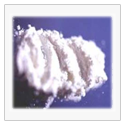|
|||||||||||||||||||
|
Types of Drugs
Heroin
Morphine is a natural alkaloid of opium, which depresses the central nervous system, and was the first drug opium to be produced in 1803. How powerful analgesic properties have been widely used to treat the wounded during the Civil War, in the middle of last century. At the end of the conflict, 45 thousand veterans were addicted to morphine, which made the medical community to make sure that the drug was dangerous and highly addictive. Even so, the United States, morphine continued to be used to treat cough, diarrhea, menstrual cramps and toothaches, and sold not only in pharmacies but also in confectioners and even by mail order. Consequently, the number of addicts began to grow, and the risks of drugs were increasingly evident, which led scientists to begin to find a safe substitute for morphine. In 1898, the laboratories of Bayer, Germany, discovered what was believed at the time be the ideal substitute: a diamorphine, a substance three times more potent than morphine. Because of this power, considered "heroic", Bayer decided to officially christen the new substance with the name of heroin. Heroin was administered to morphine addicts, and scientists have shown that the drug relieved the symptoms of morphine withdrawal. For twelve years it was believed that the heroin could replace, safe and effective, the morphine. In addition to other previously "treated" by morphine, heroin was also used as a remedy for curing alcoholism. Ironically, it was proven that heroin is more addictive than morphine and can create dependency on only a few weeks of use. In 1912, the United States signed an international treaty aimed at ending the opium trade in the world. Because of that, two years later, Congress passed a law that restricted the use of opiates, and in the same decade, created legal mechanisms that made heroin illegal. This led to a peculiar situation: before 1914, many people had become addicted to heroin using the drug as a remedy; from that year the dependents were transformed into marginal they needed to use the black market for drugs and avoid the painful symptoms withdrawal syndrome. When consumed (usually by intravenous injection), heroin may initially cause nausea and bouts of vomiting, but as the body adapts to the effects of the drug is the User to feel a state of euphoria and excitement, sometimes similar sexual pleasure. At the same time the drug induces feelings of peace, relief and satisfaction that fade sometime later. Since the effect is relatively short (about 60 minutes), the User is urged to consume new dose of drug. Within a period of constant use, he will need for increasing amounts of heroin, not for pleasure, but simply to avoid the terrible withdrawal symptoms. The heroin addict becomes apathetic, lethargic and obsessed by the drug, losing all interest in the world around him. Running out of drugs means a living hell for him, that he feels great pain, fever, delirium, cold sweats, nausea, diarrhea, tremors, depression, loss of appetite, weakness, crying spells, vertigo, etc. Despite all this, some recent theories argue that no one dies of a heroin overdose, as tests have shown that there is a lethal dose of drugs. It is said that a dose of heroin can be deadly to an addict at times, but not others. In the same way that heroin was discovered as a remedy for morphine, other substances have been researched to solve the problem of heroin addiction. One is methadone, a synthetic chemical mixture that relieves the symptoms of heroin withdrawal. Synthesized by the Germans during World War II, methadone is an opioid produced in the laboratory, little more potent than morphine. It is almost as effective when applied intravenously. Adequate doses of methadone can last up to 24 hours, so the drug has been used in the United States to treat heroin addicts. Its use is completely restricted to clinics and hospitals that apply to methadone in heroin-dependent patients, who need the drug to escape the symptoms of withdrawal syndrome. However, the addict who does not receive your dose is also likely to experience diarrhea, sweating, insomnia, and stomach pains, caused by the lack of substance. |
||||||||||||||||||

 Heroin is direct descendant of morphine, and both are so related that the heroine, to enter the bloodstream and be processed by the liver, is transformed into morphine. The drug has its origin in the poppy plant from which opium is extracted. Processed opium produces morphine, which is then processed into heroin. Poppy used in the production of the drug is grown mainly in Mexico, Turkey, China, India and also in the so-called Golden Triangle (Burma, Laos and Thailand).
Heroin is direct descendant of morphine, and both are so related that the heroine, to enter the bloodstream and be processed by the liver, is transformed into morphine. The drug has its origin in the poppy plant from which opium is extracted. Processed opium produces morphine, which is then processed into heroin. Poppy used in the production of the drug is grown mainly in Mexico, Turkey, China, India and also in the so-called Golden Triangle (Burma, Laos and Thailand).